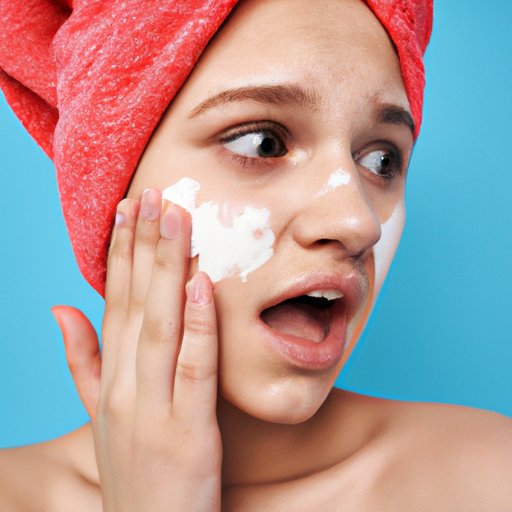
Introduction
If you’re experiencing facial redness, bumps, and visible blood vessels, you may have rosacea. Rosacea is a common skin condition that often first appears in middle age. It affects over 16 million Americans and is more common in those with fair skin. While there is no cure for rosacea, there are ways to manage symptoms and prevent flare-ups. This article will provide you with expert tips and personal stories from individuals who have learned to live well with rosacea.
5 Effective Natural Treatments for Rosacea
Natural treatments can help soothe symptoms of rosacea. Herbal remedies like aloe vera gel and chamomile tea can help soothe irritated skin and reduce inflammation. Green tea has anti-inflammatory properties and may help reduce redness. A 2013 study found that green tea extracts are effective in reducing inflammatory acne lesions when applied topically. Other dietary remedies include foods that are high in omega-3 fatty acids, like salmon, flax seeds, and chia seeds.
While natural remedies can be helpful for some people, it’s important to note that they may not work for everyone. According to dermatologist Dr. Lily Talakoub, “Natural remedies can be a great adjunct to conventional treatment, but they often do not work as a standalone therapy”.
A Dermatologist’s Guide to Treating Rosacea
If you have moderate to severe rosacea, prescription medication may be necessary to manage your symptoms. Prescription creams and gels containing metronidazole, azelaic acid, and ivermectin can help reduce redness and inflammation. Oral medications like low-dose doxycycline can also be effective.
Dr. Talakoub emphasizes the importance of sticking to a good skincare routine to control symptoms. She recommends using a gentle cleanser, a moisturizer, and a broad-spectrum sunscreen with at least SPF 30. It’s also important to avoid products that contain irritating ingredients like alcohol, fragrance, and menthol.
Finding a dermatologist who has experience in treating rosacea is key. They can work with you to find the best treatment plan for your individual needs.
Understanding Triggers: How to Prevent Rosacea Flare-Ups
Identifying triggers that cause rosacea flare-ups can be a helpful way to manage your symptoms. Common triggers include sun exposure, stress, spicy foods, alcohol, and extreme temperatures. Avoiding triggers can be a key factor in managing your symptoms. For example, wearing a broad-spectrum sunscreen with at least SPF 30 can help protect your skin from the harmful rays of the sun.
Tracking your food intake can also be helpful. This can help you identify which foods may trigger a flare-up. Additionally, stress management techniques, such as exercise and relaxation techniques like yoga and meditation, can help reduce stress levels and prevent flare-ups.
It’s important to note that triggers can be different for everyone. Identifying your personal triggers can help you learn how to manage them effectively.
Say Goodbye to Redness: The Best Makeup for Rosacea-Prone Skin
Traditional makeup products can be irritating for those with rosacea. Mineral-based makeup and those that contain calming ingredients like chamomile and aloe vera can be more gentle on the skin. When applying makeup, it’s important to be gentle. Avoid rubbing or scrubbing the face, which can exacerbate symptoms. Using a makeup brush or blender to gently apply the product is recommended.
Dr. Talakoub recommends avoiding makeup with heavy fragrances and ingredients like alcohol, which can cause dryness and irritation. A tinted moisturizer with sun protection can be an excellent choice for those with rosacea-prone skin.
Lifestyle Changes to Minimize Rosacea Symptoms
Lifestyle factors can play a significant role in managing rosacea symptoms. Reducing stress and getting enough sleep can help reduce inflammation and prevent flare-ups. Exercise can also be helpful in reducing stress levels and maintaining a healthy weight.
Other factors that can affect the skin include smoking and alcohol consumption. Quitting smoking and minimizing alcohol consumption can help improve overall skin health.
The Role of Diet in Managing Rosacea
Diet can also play a role in rosacea symptoms. Spicy foods, dairy, and caffeine can all exacerbate inflammation and cause redness. Omega-3 fatty acids, found in foods like salmon, flax seeds, and chia seeds, can help reduce inflammation and improve skin health. Drinking plenty of water and avoiding refined sugars and simple carbohydrates can also be helpful.
It’s a good idea to work with a nutritionist to create a diet plan that is tailored to your individual needs.
My Journey with Rosacea: Personal Stories and Tips for Others
Personal accounts of living with rosacea can be helpful for others who are going through the same experience. Individuals share their experiences managing rosacea and offer helpful tips and advice.
One person notes that wearing a scarf or using a portable fan can help prevent hot flashes, which can trigger a flare-up. Another shares that avoiding hot baths and showers can help reduce redness and irritation.
Overall, personal stories can provide encouragement and support to those living with rosacea.
Conclusion
Managing rosacea symptoms requires a multifaceted approach. Natural remedies, prescription medication, a good skincare routine, avoiding triggers, and lifestyle changes can all be helpful in reducing inflammation and preventing flare-ups. Identifying personal triggers and finding a dermatologist experienced in treating rosacea can be a significant step in managing the condition. With the right approach, people can live well with rosacea and maintain healthy, clear skin.





